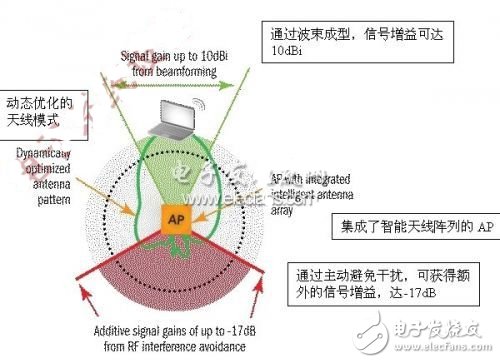The ideal goal of Wi-Fi is to send a Wi-Fi signal directly to a user and monitor the signal to ensure it is delivered to the user at the maximum rate. It constantly redirects Wi-Fi transmissions over the signal path, which is clean and does not require channel change. The new Wi-Fi technology combines dynamic beamforming technology with a small smart antenna array (so-called "smart Wi-Fi") to become the closest solution to wireless ideals. Dynamic, antenna-based beamforming is a newly developed technique for changing the form and direction of RF energy emitted by an AP. Dynamic beamforming technology focuses on Wi-Fi signals and automatically "steers" them around the interference when they are needed, that is, when interference occurs.

These systems use different antenna modes for each client and change the antenna mode when problems occur. For example, in the presence of interference, the smart antenna can select a signal mode that attenuates in the direction of interference, thereby increasing the SINR and avoiding the method of reducing the physical data rate. Antenna-based beamforming techniques employ multiple directional antenna elements to provide thousands of antenna patterns or paths between the AP and the client. RF energy can be radiated through the best path to achieve the highest data rate and lowest packet loss rate. Monitoring of standard Wi-Fi Media Access Control (MAC) client acknowledgments can determine the strength of the signal, the throughput, and the packet loss rate of the selected path. This ensures that the AP knows exactly what the customer's experience is, and that in the event of interference, the AP has complete control over choosing the best path.
Smart antenna arrays also actively reject interference. Since Wi-Fi only allows one user to be served at the same time, these antennas are not used to transmit data to a specific client, but to all clients, so that they can ignore or reject those that normally suppress Wi-Fi transmission. Interference signal. The result is a signal gain of up to 17 dB in some cases. Perhaps the biggest benefit of this new technology is that it can run automatically without manual adjustment or manual intervention. For network administrators, it is becoming more and more important to solve the problem of radio frequency interference due to the impact of a large number of new Wi-Fi devices on the enterprise network. At the same time, users are increasingly demanding Wi-Fi connection reliability, and the demand for supporting streaming media applications is increasing. Addressing RF interference issues is key to adapting to these trends in enterprise development. But to achieve it means using smarter and more adaptive methods to deal with out-of-control radio frequencies, which are the source of all these interferences.
Induction Cooker Main Board,Motor Starter Button,Ignition Starter Switch For Foton,Main Spindle Induction Motor
Ningbo Zhenhai Rongda Electrical Appliance Co., Ltd. , https://www.centrifugalswitch.com